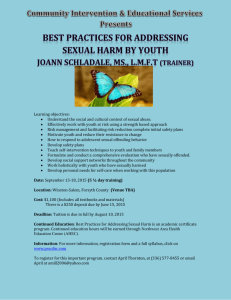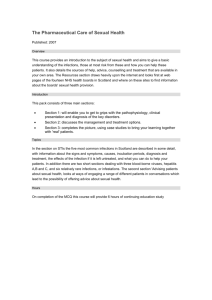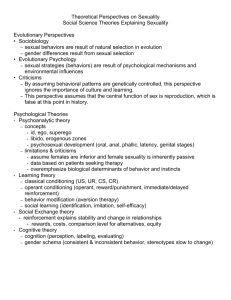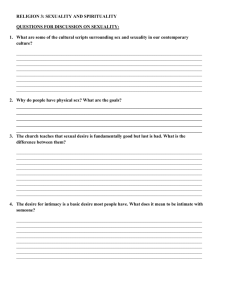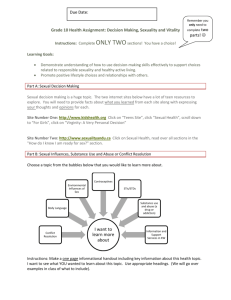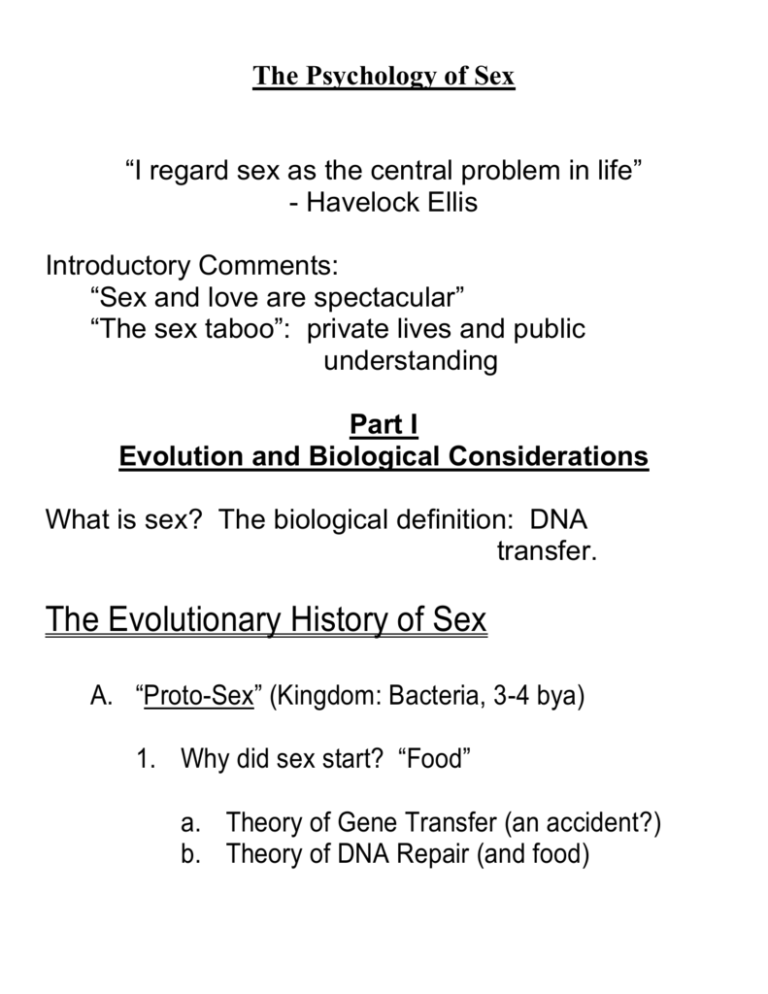
The Psychology of Sex
“I regard sex as the central problem in life”
- Havelock Ellis
Introductory Comments:
“Sex and love are spectacular”
“The sex taboo”: private lives and public
understanding
Part I
Evolution and Biological Considerations
What is sex? The biological definition: DNA
transfer.
The Evolutionary History of Sex
A. “Proto-Sex” (Kingdom: Bacteria, 3-4 bya)
1. Why did sex start? “Food”
a. Theory of Gene Transfer (an accident?)
b. Theory of DNA Repair (and food)
2. Why did sex continue? “Variety”
a. Theory of DNA Repair, continued (e.g.
more mutations)
b. The Red Queen Analysis (e.g. parasite
resistance)
B. “Early-Sex” (Kingdom: Protists, 2½ -3 bya)
Cellular organisms, becoming multicellular
(1½ bya)
Sex for food producing genetic variety
Evolution of meiosis from mitosis (haploids from
diploids)
C. “Later-Sex” (Kingdom: Fungi, 1½ bya)
Sex for reproduction (½ bya)
1. Why did sex for reproduction start now? An
accident of meiosis?
2. Why did sex for reproduction continue?
The Red Queen Analysis
3. Why the sexes? From isogamy to anisogamy
(sperm and eggs)
D. “Modern Sex” (Kingdom: Plants and Animals, ½ bya)
I.
The Paleozoic Era (“The Age of Ancient Life”,
500-250 mya)
The problem: a time and a place….
The evolution of sexual desire
The Terrestrial Plants: both sexual and asexual
reproduction
e.g. Gymnosperms and angiosperms
The Insects: sexual combined with asexual
reproduction
e.g. Haplodiploidy
The Fish: sexual reproduction with changeable
sexes
e.g. Hermaphroditism
II. The Mesozoic Era (“The Age of Reptiles”, 250-65
mya)
The problem: another individual (of the opposite
sex)….
The evolution of sexual attraction
The Amphibians: both external and internal
fertilization
e.g. Pheromones
The Reptiles: internal fertilization and an
investment in the results
e.g. Penis and parenthood
The Early Mammals: the mammalian forms of
parental investment
e.g. from monotremes and marsupials to
placentals
III. The Cenozoic Era (“The Age of Mammals”,
65 mya-now)
The problem: parental investment….
The evolution of sexual attachment….
and the Battle of the Sexes
The Determinants of Sexual Differentiation:
beyond the “Organizational” concept (genes)
to ecological factors.
Temperature and behavior–dependent sexual
differentiation
e.g. simultaneous and sequential
hermaphrodites and the special case of
parthenogenesis.
Gene-dependent sexual differentiation
e.g. our Y chromosome
Implication for our concepts of “male” and “female”
e.g. heterotypical and homotypical behavior
Summary: the sex lives of species like us
The evolution of two separate sexes and
parental investment
i.e. Battle of the Sexes
The emergence of alternative sexual strategies,
based on
1. Past: i.e. “inherited commitments”
2. Present: i.e. “ecological parameters”
The animal with the weirdest sex life….
Human Sexuality from an Evolutionary
Perspective: Basic Principles.
A. Parental investment and possible mating systems
1. Polygamy: polygyny, polyandry, and
polygynandry
2. Monogamy: social, sexual and “serial”
monogamy
3. Promiscuity: the alternative, for either sex
Examples: precocial & altricial birds and “the lek”
B. From Natural Selection to Sexual Selection
1. Intrasexual Selection: direct and indirect
competition
Males in conflict with other males
Females in conflict with other females
2. Intersexual Selection: making choices
Males choosing among females
Females choosing among males
a. “Good taste”: The Runaway Selection Model
(and the “Sexy Son Scenario”)
b. “Good sense”: The Healthy Offspring Theory
(and the “Handicap Principle”)
The dilemmas of sexual selection:
Who is making the choices?
What makes good sense?
When does it matter?
Summary: “The Battle of the Sexes” (Part I):
The interpersonal conflict and its management:
Some tactics and countertactics
e.g. “cryptic choice”
Some examples of war and peace
e.g. spotted hyena and the bonobo
Human Sexuality from an Evolutionary
Perspective: Human Prehistory
I.
Prehominids: sex life in the jungle (Miocene
Epoch: 25 - 5 mya)
The elaboration of sexual desire in primates
…with promiscuity and polygynous mating?
II. Hominids: sex life on the plains (Pliocene
Epoch: 5 – 2 mya)
The elaboration of sexual attraction in hominids
…with sexual selection by (male) competition?
III. Sex Life in the Pleistocene Epoch: sex life of a
bipedal mammal (Pleistocene Epoch:
1.6 mya – 10,000 years ago)
The elaboration of sexual attachment in humans
…with socially monogamous mating and sexual
selection by female choice?
The Choices of Paleolithic Humans:
Who made choices?
What was the basis for choice?
Some implications?
The Fitness Matching Model
Good sense, good rules (e.g., age, kin, kids)?
Some implications?
The Results of Natural and Sexual Selection
Natural selection: “slow, stupid and evil”
The perils of Social Darwinism
Sexual selection: “faster, wiser and better”?
Example: altruism
Results: directed and stabilizing selection
Examples among psychological traits
Now: “The Battle of the Sexes” (Part 2):
The intrapersonal conflict and its management….
Human Sexuality from an Evolutionary
Perspective: The Red Queen Analysis
1. Polygamy and the Nature of Men: The Polygyny
Threshold Model
When is monogamy a good idea?
Inherited commitments and ecological
parameters
Examples among birds, other primates and
human history
2. Monogamy and the Nature of Women: The Emma
Bovary model
When is monogamy not a good idea?
Inherited commitments and ecological
parameters
Examples among birds, other primates and
human history
Summary: The Dual Nature of each Sex:
The monogamies and their alternatives within us
The intrapersonal (”psychodynamic”) conflict and its
management
Some examples in same-sex relationships in humans
Why are we “the animal with the weirdest sex life”?
A. The evolution of sexual reproduction and
the two sexes: the emergence of the
“Battle of the Sexes” in mammals, like
humans.
B. The evolution of pair-bonding in social
species: the emergence of the “Dual
Nature of the Sexes” in many birds, and
in humans.
Human Sexuality from an Evolutionary
Perspective: The Results
Adaptations or accidents?
A. Women
1.
2.
3.
4.
Also
Hair: natural and sexual selection
Breasts: male and female choices
Clitoris: homologues and analogues
Orgasm: androcentric and gynocentric views
1. Reproductive inscrutability (concealed
ovulation)
2. Private sex (cryptic copulation)
3. Sperm management (cryptic choice)
4. Menopause (cryptic cessation)
Summary: “Sexual inscrutability” (an adaptational
perspective)
B. Men: Similarities, not differences
1. Testes: size and production
2. Penis: natural and sexual selection
Summary: The evolution of flexibility and choice, for men
and women (“freedom” as an adaptation)
C. Men and Women, together
1.
2.
3.
4.
Private sex and the “sex taboo”
Coolidge Effect and the “double standard”
Incest and the “incest taboo”
Sex and death
Mating Strategies
1. The original idea (Robert Trivers)
Mating effort and Parenting effort = Reproductive
effort
i.e. Very different mating strategies for males
and females
2. Sexual Strategies Theory (David Buss)
“Short-term” & “Long-term” mating strategies
i.e. Somewhat different strategies…
3. Strategic Pluralism Theory (Simpson & Gangestad)
Multiple factors in mating strategies
i.e. More flexibility and choice, for both sexes
Sex and Coalitions
Mating-effort and parenting-effort coalitions
Men in groups and women in groups
Cooperation and competition
Human Sexuality from an Evolutionary
Perspective: Some Comments
1. The nature of women: mothers and others
2. The nature of men: providers and others
The evolution of evolutionary psychology
Adaptations and accidents
Exaptations: by-products and “spandrels”
Sociobiology and “cultural biology”


